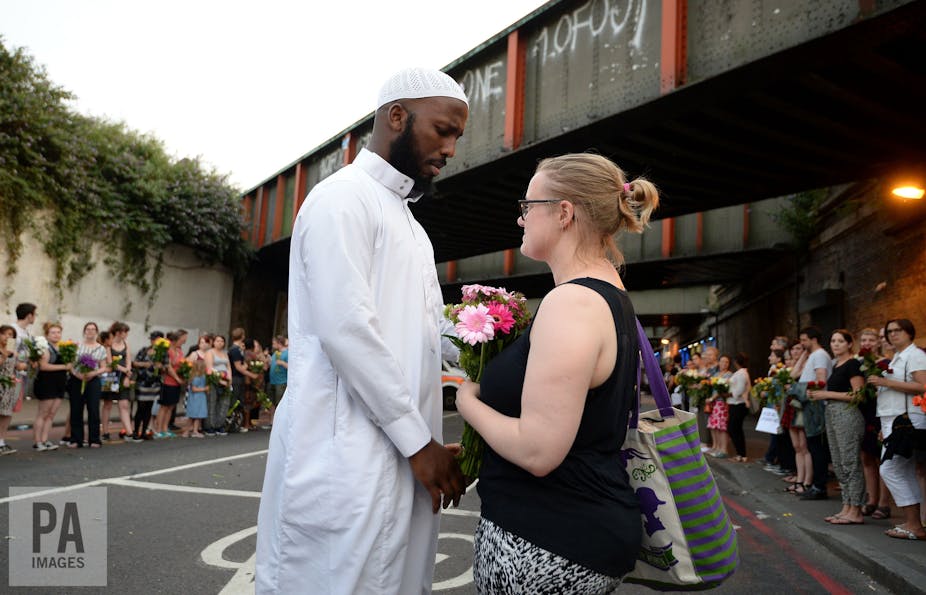Finsbury Park is a bustling, diverse and vibrant area in north London. It is a neighbourhood which typifies the multicultural metropolis that has emerged in cities across the world as a result of globalisation. Over a hundred languages are spoken in the area and foodstuffs are on sale from every corner of the world.
After an atrocious terror attack on Muslim worshippers leaving Muslim Welfare House after breaking Ramadan fast in the early hours of the morning on June 19, hundreds of people attended a vigil in Finsbury Park to lay flowers and show solidarity. They held signs saying “United against all terror” and “#WeStandTogether”.
The mood in the area has been understandably sombre since the attack, with Muslim communities concerned by the very tangible threat of Islamophobia. And yet Mohammed Kozbar, chairman of Finsbury Park Mosque near the site of the attack, echoed a general sentiment: “We all have harmony in this area, and these people try to divide us, but we tell them that ‘we will not let you do that’.”

Never static
The recreation ground of Finsbury Park was opened in 1869 as the first public open space in Hornsey for Islington Parish’s urban and overcrowded residents. In the decades that followed, the area became rapidly urbanised, built up as a commuter suburb for the new middle classes. By the 1920s the area had fallen on hard times, many houses became multiple occupancy and working class communities moved in from other parts of Islington. As a result, by the 1930’s in streets such as Campbell Road 30% of houses had become overcrowded
Many migrant communities found their home in the area after World War II. It moved from being a largely Irish area to an Afro-Caribbean one in the decades following the war, as a Monserratian diaspora settled there. As time went on, Greek Cypriots and later Turkish Cypriots became established, developing the rag trade centred on Fonthill Road. As the Cypriot populations began to move on, Turkish and Kurdish communities made the area their home, particularly to the north in neighbouring Green Lanes. By the 1980s and 1990s, Somalis refugees had began to settle.

Today, depending on how you define the boundaries of Finsbury Park, it is home to some 30,000 to 60,000 people across the boroughs of Islington, Haringey and Hackney. The area now has a large population churn, and as one Finsbury Park community worker told me as part of my ongoing PhD research on the diversity of the area:
There’s a lot of migration, that’s what I hear from people, they’re here for a short amount of time, whether it’s [due to] housing or whether it’s to a better place.“
A superdiverse neighbourhood
The area could now be called "superdiverse”, meaning the migration has become more complex, and is no longer in the form of post-war waves of people coming for specific jobs. Diversity has many forms and residents vary by religion, ethnicity, legal and employment status, sexuality and class.
These days Finsbury Park is recognised for its North African presence with the top of Blackstock Road being colloquially called by some “little Algiers”. But a resident you meet on the street could equally be Polish, Congolese or Venzeulan. Languages spoken in the neighbourhood include Amharic, Portuguese and Albanian.
Through my research in the area I have found one of the biggest threats to Finsbury’s Park way of life is gentrification, the displacement of working class and migrant communities. It is clear the area is changing and the influx of larger corporate supermarkets, coffee chains and developments threaten the uniquely independent character of the area.
It now includes pockets, just streets apart, which vary from being among the 2% most deprived in the country to the 50% least deprived, in part due to the diversity of housing provision, ranging from social housing flats to sought after period houses in close proximity.

Yet amid this change, the multicultural metropolis shows no sign of receding. It is there to see on the street, at the convivial café, newsagent or park and through community and social interactions. Finsbury Park’s streets are superdiverse not just through the bodies moving through them, but through the goods that are sold there, the languages spoken, the smells of different foods cooking and through the interactions that occur.
You cannot walk down the street without being exposed to the multitude of lives being lived simultaneously. It is a place of intersection and exchange and it facilitates mobility, particularly as tens of thousands of people move through Finsbury Park every day through its transport hub.

Amid all this, residents maintain respect for others and the area’s multiculturalism, often because they appreciate the difference of their neighbours. For example, in 2013 after women from St Thomas’ church and Finsbury Park Mosque realised they were based on the same street and yet hardly knew each other, they decided to set up a sisters group, meeting every couple of months to share lunch and tea, chat and practice a unique form of inter-faith solidarity.
These gestures of everyday multiculturalism show that Finsbury Park won’t be divided by an attack on its freedom precisely because its residents celebrate their differences. It is a neighbourhood which doesn’t seek sameness but thrives on variation and refuses to be defined. In the face of hate it unites, not in spite of, but because of its diversity.

